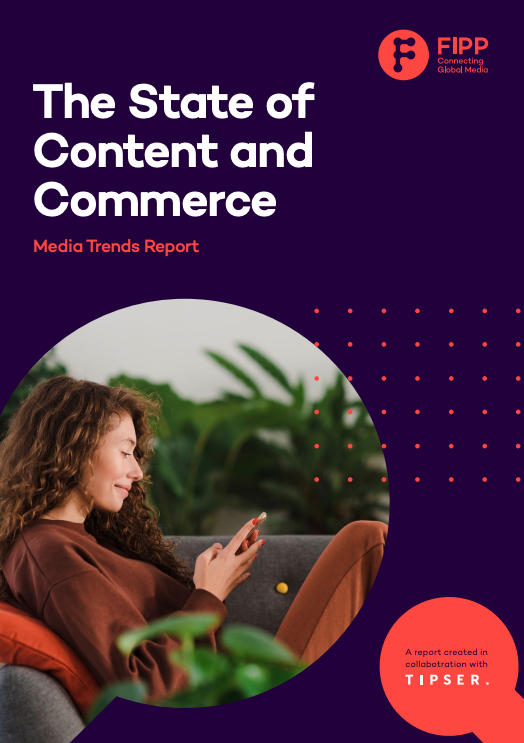Commercial opportunities and the new ecommerce
Ecommerce has been on quite a journey. In the early days, media brands would sell branded products to subscribers. Then came affiliate marketing, where readers are sent from publications to external shopping destinations, a process that became more refined and precise over time. The latest adaptation in this evolutionary chain is known as embedded ecommerce or content commerce, where readers simply buy products directly from the publications they read, rather than being forwarded to an external vendor – and it’s exciting for a number of reasons, according to a new report, The State of Content and Commerce.
Launched by Tipser, an ecommerce facilitation platform, and supported by FIPP, the report highlights the fact that more media brands could be taking advantage of the revenue opportunities generated by embedded ecommerce or content commerce.

What’s special about the new ecommerce?
During a FIPP webinar on 28 January, Tipser founder and CEO Axel Wolrath told the audience that embedded ecommerce allows publishers to shift away from over-reliance on a single revenue stream, all the while cementing trusted relationships with readers.

More readers than ever are flocking to digital sites, yet subscriptions and advertising aren’t keeping pace. Netflix and Spotify have hundreds of millions of paying users, yet by comparison the media brand with the most subscribers, The New York Times, boasts just 6.5 million.
To compensate for this, diversifying revenue streams via new ecommerce models is absolutely essential, said Wolrath. He projects that this way of monetising digital media is set to become an integral – and more reliable – part of both mainstream and smaller, niche publishers’ revenue streams in the future. That’s partly because content commerce smooths out the old trade-off between high-quality journalism and intrusive advertising by taking the best of both those worlds.
A chance for publishers to own offers and services themselves
A lot of publishers are thinking, “We have to start owning the interaction with our customers.” This is part of the offering of embedded ecommerce and content commerce, explained Wolrath, since a publisher then owns or licenses the products it sells to its audience rather than directing them away.
Embedded or native shopping experiences are becoming more common, and the profit potential is much higher than classic affiliate solutions. A key statistic is that whereas affiliate commission rates average between 3-7 per cent, embedded ecommerce leads to an average commission level of 20 per cent: “the upselling of relevant products is the new secret weapon in the monetisation battle.”

Embedded ecommerce: three key use cases
There are three ways that publishers are currently taking advantage of the new opportunities to marry up commerce with content.
- Embedded ecommerce: Often presented as banners separate to editorial, embedded ecommerce is built by matching pieces of content with specific products.
- Content commerce: Also known as shoppable content or product-first commerce, this works in the opposite way to embedded ecommerce. Products that fit readers’ tastes are selected first, then content is generated around those products. This has worked especially well for Elle and InStyle in Germany, both clients of Tipser’s, and other lifestyle and fashion brands.
- Reader loyalty: Every publisher has their own loyal audience and can leverage this by making exclusive offers – such as heavy discounts, limited edition artworks, or early access to events – available to members or subscribers. These “loyalty perks” enhance the service on offer, explained Wolrath. “Uplifting these perks makes subscriptions more attractive, because it’s a great value deal for the subscriber,” he added.
More examples of all three can be found in the full report.
Content and commerce should be integrated
With the digital sphere opening up an entirely new framework for b2c interactions, readers are no longer “just” readers – they are users, members, consumers. And digital platforms reflect that. Reading an article online today can mean interacting with external links, ads, images, graphics, and sidebars of things they might want to buy – and yet most publishers aren’t taking advantage of this to its full potential, said Wolrath.
“If you’re not using all that space, you’re not utilising your full digital real estate,” he explained. “All in all, embedded ecommerce creates a better experience for readers to read commerce embedded within the content. It’s an improvement on the service you are providing to the reader.” After all, publishers know their audiences better than anyone – so why shouldn’t they make product suggestions that readers might like?
As the report explains, the old advertising model was based on interrupting the reader journey, moving them out of one context and into another. At Tipser, they think that commerce should be in the stream, not offering readers stepping stones out of the stream.
“When is the consumer ready to interact? When the content is relevant,” added Wolrath. “With embedded ecommerce, publishers have the opportunity to turn away from the old two-sided market model in the pursuit of achieving real independence for the first time.”
Don’t look upon commercial activities as something dirty, that you want to hide away in a corner or not take responsibility for.
Axel Wolrath, Tipser
Being upfront about what commercial is all about
Being ultra-transparent is the best way to get around the separation of church and state – namely, the perceived chasm between those that produce commercial content, and those that produce independent, unbiased news coverage. There is no reason why monetisation through ecommerce should negatively impact a brand, and readers will perceive clearly signalled commercial content as added value, reads the report.
“There’s a lot of caution from publishers, who spend their years and lives building a trusted brand,” explained Wolrath. Rather than distancing themselves, Wolrath noted, publishers should embrace ecommerce by telling the reader: this is our way of making money. This may be more effective in an age where readers are more aware that media brands are vulnerable, trusted coverage is highly sought after, and paywalls and subscriptions are now expected among news brands especially.
One example of embedded commerce might be in a review of a cookbook, in which the reader can buy the cookbook while reading about it. “It comes down to transparency and signposting – this is our commercial offering to you, we’re signalling that we think is very relevant and interesting to you, the reader,” said Wolrath. “Simply placing a book there shows that contextual relevance works.”
This kind of ecommerce is quick to set up, too: according to Aftonbladet, the biggest news platform in the Nordic countries, they “sold 300 books with 3 minutes of work” after enlisting the services of Tipser.
Diversification is the future
Of course, there’s always a risk in trying something new – but as the report emphasises, there are risks to not trying it, too. New approaches to monetisation don’t have to mean the end of the road for another – they can coexist quite happily, since a healthy balance is achieved through having several revenue sources.
Wolrath ended by stressing transparency once more. “We’ve found that clarity about the offering effectively safeguard us from the risks of being perceived as biased or skewed,” he said. He also advised: “Don’t look upon commercial activities as something dirty, that you want to hide away in a corner or not take responsibility for.”
Instead, embedded ecommerce and content commerce can be framed as an offering: “We want to be your one-stop shop. We want to provide you with the full experience. You’re turning yourself into an arena for interactivity and deeper relationship with your customer who’ll come back.”
Download the full “The State of Content and Commerce” report here.











